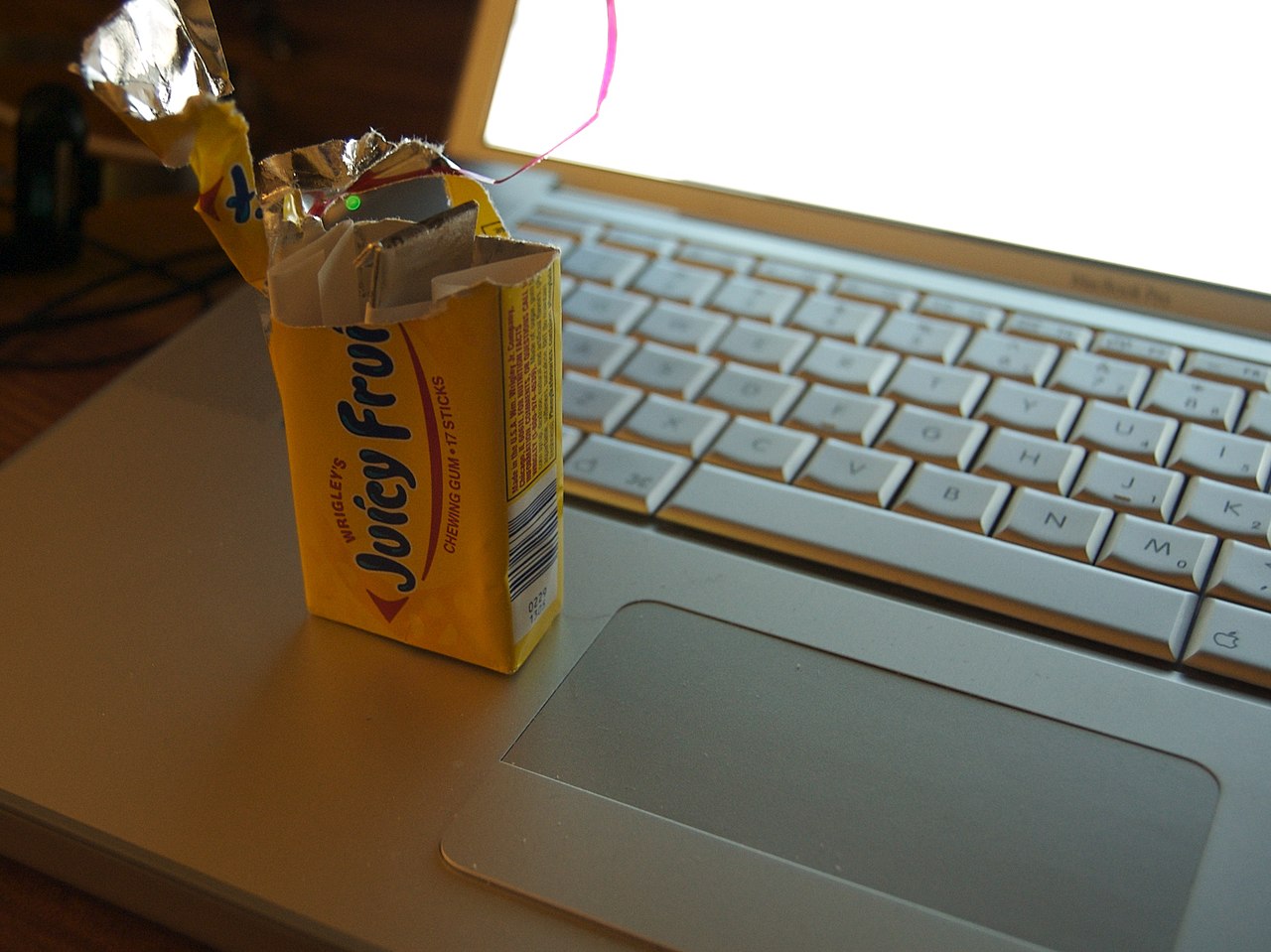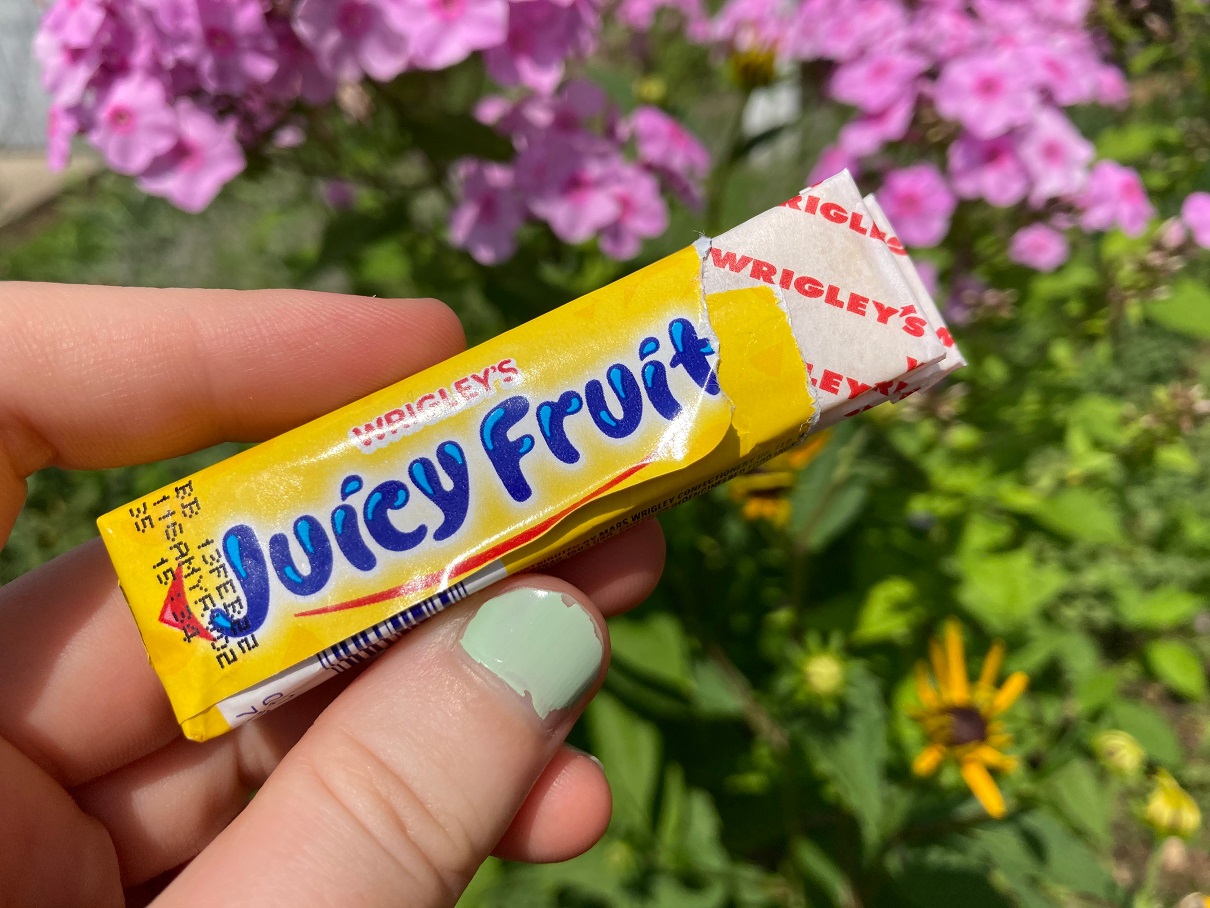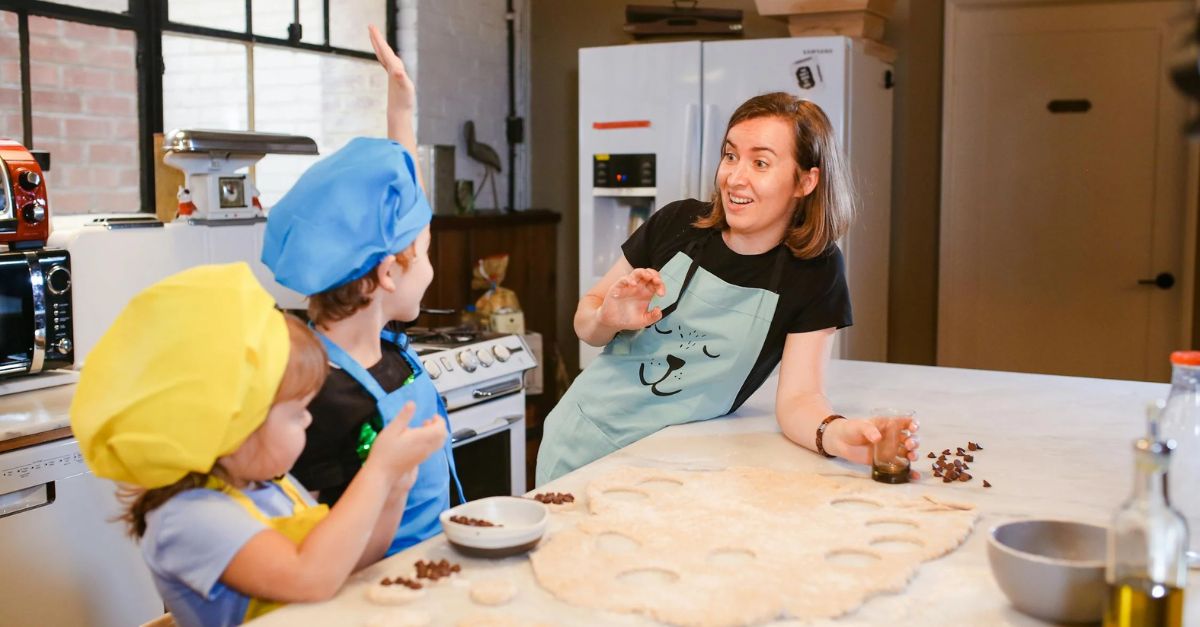What IS That?
Natural and artificial flavorings have led to some seriously delicious products—ice-cold Coca-Cola, anyone? But have you ever sat down and wondered what real flavors these products are attempting to mimic? From fruits that aren’t so juicy to raspberries that aren’t so blue, the world of flavors is full of surprises.

Juicy Fruit
Talk about a triple threat: there’s the iconic name, the unmissable yellow wrapper, and then, of course, the flavor. These three things make Juicy Fruit gum one of Wrigley’s most popular products, especially among kids—but what the juicy fruits in Juicy Fruit?
Juicy Fruit’s History
Juicy Fruit was created in 1893, and by 1914 came in a—gasp—green and white striped wrapper. But that’s not even the strangest part of the Juicy Fruit journey. When it first came out, it was mint-flavored. Yup, it didn’t even get that signature fruit flavor until 1914.
Juicy Fruit Acquires The Fruit
The gum ceased production during WWII, but afterward, it came back with a bang. That’s when Juicy Fruit acquired its famous yellow wrapper, which also boasted its “fascinating artificial flavor”. But as fascinating as it is, it has to be based on something real, right?
Juicy Fruit: The Taste Is Gonne Move Ya
Some have claimed that Juicy Fruit’s flavor is a mix of pineapple and banana, while others say that it tastes like jackfruit. In 2002, Wrigley said that the exact formula is too valuable to the company to give away, but did share that it involves a combination of banana, pineapple, oranges, and lemon.
For now, we have to take their word for it—though there are plans to concoct a smoothie that tests this combo.
 Alexander Staubo, CC BY-SA 2.0, Wikimedia Commons
Alexander Staubo, CC BY-SA 2.0, Wikimedia Commons
Bubblegum
Juicy Fruit isn’t the only gum out there with a mysterious past—but looking into bubblegum’s flavor presents another unique set of problems. For one, there are so many different brands of bubblegum, each with its own different flavor. But there’s one thing they all have in common.
Bubblegum’s History
It all began in 1928, as an employee of the Fleer chewing gum company experimented with a new formula which was less tacky and more stretchy than previous gums. It was a drab grey color, so he added red dye to make it pink—and thus, bubblegum was born.
Dubble Bubble
The president of Fleer named the product bubblegum and branded it as Dubble Bubble—a name that’s still on the market today. The Dubble Bubble we know is apparently a mix of artificial fruit flavors that contains banana, strawberry, and cherry, though it’s certainly hard to pick out any one in particular. That’s because one ingredient dominates in bubblegum.
The Real Flavor Of Bubblegum
Every company has their own flavor of bubblegum, incorporating a mix of artificial flavors replicating cherry, orange, lemon, raspberry, and/or blueberry. Generally, the closest analogue might be a creamy strawberry-banana concoction. But the most recognizable component of bubblegum really isn’t its flavor anyway, is it?
Bubble-Yum
What really makes bubblegum so iconic and memorable? Its distinctive smell! While our taste buds have access to just a few flavors, our olfactory senses can smell up about a trillion scents. The esters in bubblegum are what really makes it one-of-a-kind.
Red Bull
Take one sip from a can of Red Bull and try and tell me that flavor is trying to replicate something from nature. Perhaps even more so than Coca-Cola, Red Bull has one of those flavors that’s basically impossible to pinpoint—and it goes back to the drink’s strange story.
Red Bull History
If you’re old enough, you just might remember the era before energy drinks took up multiple fridges in the convenience store, and before Red Bull came in its signature blue and silver can. The drink was primarily inspired by a Thai energy drink called Krating Daeng. Executives created a similar formula in the 1980s, called it Red Bull, and pushed it as a luxury product.
Red Bull Vs Krating Daeng
Before Red Bull in the slim can was widely available, you might occasionally see a brown bottle of Krating Daeng lurking on store shelves. Both had the recognizable logo of two bulls locking horns and both were referred to colloquially as “Red Bull”—but both are owned by different companies and have completely different formulas.
Red Bull Flavor
Another thing both drinks had in common? They were considered “medicinal” at one point—and that just might be where Red Bull’s signature flavor comes from. The flavor itself is medicinal, kind of like a cherry-flavored cough syrup. While there may be other elements in it, it’s certainly the closest match that makes sense.
Ranch Dressing
After America’s favorite soda comes one of its favorite condiments: ranch dressing. While other dressing names, like blue cheese, balsamic, and honey mustard, the name “ranch” doesn’t exactly explain much—though, of course, once you’ve had it, you just might be hooked.
The Original Hidden Valley
In 1945, a man named Steve Thayer invented a new salad dressing—though, for many years, it was just something he made for family and guests. Eventually, in 1956, he opened a dude ranch he called Hidden Valley Ranch. Once guests arrived, he served them his salad dressing—and and an icon was born.
 Famartin, CC BY-SA 4.0, Wikimedia Commons
Famartin, CC BY-SA 4.0, Wikimedia Commons
Ranch Dressing History
It didn’t take long before he started selling to local restaurants, and then making packets of mix to sell by mail order. Eventually, he opened a factory to produce his ranch dressing, and eventually sold it to Clorox for $8 million. Before long, copycats selling “ranch-style” dressing popped up—but hey, they weren’t Steve’s problem anymore.
 J Doll, CC BY 3.0, Wikimedia Commons
J Doll, CC BY 3.0, Wikimedia Commons
Ranch Vs. Ranch
Though copyright issues popped up, they didn’t come from other ranch dressing companies—instead from Conagra, which had a product called Ranch Style Beans. They targeted Hidden Valley’s copycats, in an ironic twist of fate. But hey, what about those flavors?
Ranch Dressing’s Flavors
Homemade ranch is made of buttermilk, salt, garlic, onion, mustard, herbs (commonly chives, parsley and dill), and spices (commonly pepper, paprika and ground mustard seed) mixed into mayo, sour cream, or yogurt. And you may have noticed: not a lot of secrecy around this one.
Hidden Valley’s Flavors
Unlike Coca-Cola or Juicy Fruit, Hidden Valley never really kept their blend a secret. The packet lists salt, buttermilk, garlic, and spices, among other things—and the bottled stuff isn’t that different. The variety of formats and brands has been at least one driving force in ranch’s domination—it’s the most popular salad dressing in the US since 1992, when it unseated Italian.
Dr Pepper
The mystery of Dr Pepper’s flavor has a lot in common with Coca-Cola—which makes sense, since CC owns DP. The formula is a trade secret, and purportedly kept in separate documents housed in two separate banks in Dallas, Texas. Sound familiar? Well, Dr Pepper’s history has just as many twists and turns—if not more—than Coca-Cola.
Dr Pepper History
Dr Pepper has been around for a whopping 139 years—one year older than Coca-Cola. It was considered medicinal (like so many other drinks) in the old soda fountain days, One of its purported purposes was as a digestive aid—which sparked a strange rumor.
Dr Prune-per?
In the 1930s, a rumor spread that the primary ingredient and flavoring in Dr Pepper—and the one that helped with digestion—was prune juice. The story spread so far and endured for so long that even today, the FAQ on the Dr Pepper website refutes it, saying explicitly “it does not contain prune juice”.
What’s In A Name?
Could the company have hinted at the drink’s flavors in its name? Well, it’s a lot more complicated than you might think. The history of the name is as murky as the source of the flavor. While it’s likely there was no actual doctor named Pepper associated with the soda, it’s disputed as to who or what the “Pepper” in the name was.
The Name Game
Not only is there confusion over the name, there’s also debate over what exactly Dr Pepper is. It’s a soda, surely—but what kind? The FDA actually confronted this conundrum. Ultimately, they decided that its neither a cola, nor a fruit-flavored soda, nor a root beer. They gave it its own classification: pepper soda.
So, What Flavor Is It?
Dr Pepper claims to be a “unique blend of natural and artificial flavors”—but that doesn’t really tell us much, does it. Its slogan in 1945 was “Dr Pepper has 23 flavors”. Still cold. That’s really all they’re willing to give away—so we have to go on speculation.
23 And Me
Among the speculators, there is a consensus that the following flavors are the 23 that make up Dr Pepper—deep breath: amaretto, almond, blackberry, black licorice, caramel, cola, clove, carrots, cherry, ginger, juniper, lemon, molasses, nutmeg, orange, pepper, plum, prune, raspberry, root beer, rum, tomato, and vanilla. Phew.
Blue Raspberry
The name seems straightforward enough—but when you think about it, it kind of falls apart. After all, there’s not really a so-called “blue raspberry” in nature, is there? And even if there is—there’s no way it’s the vibrant blue that characterizes “blue raspberry” flavor candy or drinks.
The Real Blue Raspberry
Well, there are technically two different blue raspberries out there in nature…kind of. Blue raspberry is a nickname for both Rubus leucodermis, a species of North American raspberry, and the hybrid raspberry plant made from Rubus strigosus and Rubus occidentalis. But while they claim to be “blue,” they don’t actually have anything to do with blue raspberry flavor.
Blue Raspberry History
In the 1950s, snow cone makers needed a new flavor. Cherry, strawberry, and watermelon already had a monopoly on reds and pinks, which left raspberry out in the dark. So, someone at the Gold Medal food company really thought outside of the box.
What Makes Blue Raspberry Blue?
Gold Medal spun their problem on its head and created “blue raspberry” flavor, utilizing brilliant blue food dye, to differentiate the raspberry flavor from others. Though Gold Medal has the first recorded usage of blue raspberry, it became popular for a different reason in the 1970s.
 Michelle Lee Photography, Shutterstock
Michelle Lee Photography, Shutterstock
The Danger In The Dye
The popularity of blue raspberry took off in the 1970s because of concerns surrounding another dye—FD&C Red No 2, a dark red dye that had been previously used by some companies to signify raspberry flavored foods. In 1976, it was banned for being addictive, causing a huge panic. M&M even had to cease making red candies for a while…even though they’d never even used that dye.
But Is It Even Raspberry?
Raspberry fruit proved to be a hard flavor for food scientists to recreate in artificial form—and for that reason, blue raspberry flavored treats aren’t even really raspberry flavored! Artificial raspberry flavor contains mostly esters of the banana, cherry, and pineapple variety.
Duck Sauce
What’s bright orange, comes in a tiny packet, and has a very misleading name? Duck sauce, of course. If you’ve gotten Chinese takeout at one of the less “authentic” restaurants in the US, it’s entirely possible you might have gotten packets of duck sauce whether or not you ordered duck. So…what’s up with that?
 Plastik klinik., CC BY 2.0, Wikimedia Commons
Plastik klinik., CC BY 2.0, Wikimedia Commons
Duck Sauce Origins
The history of duck sauce is somewhat inscrutable, though it was likely created to cater to more, should we say, unrefined American palates as Westernized Chinese food became more popular. It’s likely an adaptation of tianmian sauce, a sauce from Northern Chinese cuising commonly served with duck.
 SunnyPie, CC-BY-2.0, Wikimedia Commons
SunnyPie, CC-BY-2.0, Wikimedia Commons
Duck Sauce Flavor
Well, first things first: duck sauce isn’t made with duck, if you hadn’t figured that out already. It’s meant to be served with duck, among many other dishes, and is commonly made from fruits, which can include plums, apricots, pineapples, and/or peaches, as well as to sugar, vinegar, ginger, and chili peppers.
Mountain Dew
Okay, yes—it seems clear enough. Mountain Dew, the neon-green beverage choice of gamers everywhere, is a citrus soda. But like…what citrus exactly tastes like that? And what does that have to do with condensation upon a mountain? Looks like PepsiCo’s #2 most popular soda runs a little deeper than you’d expect.
Mountain Dew History
The origin story of Mountain Dew is pretty hilarious, actually. A pair of brothers in Knoxville, TN, couldn’t find the soda that they liked to mix with the hard stuff-specifically, whisky—and so they decided to mix up their own. They named it after a popular nickname for Highland Scotch whisky—and Mountain Dew was born.
Mountain Dew Flavor
The Mountain Dew flavor was revised by another owner in 1961 before it was finally purchased by Pepsi in 1964. Pepsi boasts of its “one-of-a-kind” citrus taste, and many people taste hints of lemon, lime, and orange, but little more can be said of its signature citrus blend beyond that. But then, of course, there are the many variants.
Bonus: Baja Blast
Baja Blast is one of the Mountain Dew brand’s most enduring offshoot flavors. It was developed for Taco Bell in 2004, but…what exactly is a Baja Blast? PepsiCo claims it is a “Mexican-inspired tropical lime” flavor, but its pale blue-green color seems to be a lot more complex than that. Some tasters have noted flavors of pineapple, mango, lemon, and lime.
Red Velvet
When red velvet started to really have a moment in bakeries across the nation (specifically, outside the American South) in the 2000s, many people just thought that it was a heavily-dyed chocolate flavor—but it turns out that the cake flavor actually has a story that’s just as deep as its rich maroon color.
Red Velvet History
The history of red velvet cake isn’t exactly linear, like other foods on this list. Though some cookbooks began to reference it in the mid-19th century, it developed in different places at different times. When raw cocoa hit store shelves around 1900, people began to use it in place of chocolate in cake recipes—and when it met acidic ingredients in the batter, it gained a strong red hue. But that hasn’t been the only source of the red.
 Jennifer from Vancouver, Canada, CC BY 2.0, Wikimedia Commons
Jennifer from Vancouver, Canada, CC BY 2.0, Wikimedia Commons
Paint The Town Red
During WWII, when foods were rationed, people used beetroot to color their red velvet cakes. Later, when food dyes were introduced, those were also used. Red velvet cake became a popular part of Juneteenth celebrations in the South, as well—though the Waldorf-Astoria hotel did try and take responsibility for its popularity.
Red Velvet Flavor
So, is red velvet flavor cocoa, or beet, or just chocolate? Well, it’s whatever your recipe makes of it—but generally, if you see a slice hanging out in your local bakery, it’ll have a more muted chocolate flavor than, say, a rich slice of chocolate cake or devil’s food fake.
Coca-Cola
It’s one of the most closely-guarded trade secrets in history: the formula for Coca-Cola syrup, which, when combined with carbonated water, makes up the world’s favorite soda. At first, the secrecy that surrounded it was just a marketing tactic, but as the years went on and competitors popped up, it became clear that the Coca-Cola company needed to keep it hidden.
Coca-Cola History
The Coca-Cola you might grab at a 7/11 today doesn’t have the same flavor as the original formula. As you may have heard, earlier formulations even contained now-illegal stimulants derived from coca leaves, hence the name.
More Serious Than The Secret Service
According to company representatives, only two employees of Coca-Cola at a time are allowed access to the formula, which stays in a vault in company headquarters. These employees aren’t allowed to travel together, and when one passes on, the surviving employee must choose that person’s successor.
 Conrad Poirier, Wikimedia Commons
Conrad Poirier, Wikimedia Commons
Coca-Cola Flavors 1 Through 9
In order to keep the formula a secret on such a large industrial scale, Coca-Cola ships out the nine components that make up the syrup in numbered yet otherwise unmarked containers, and gives instructions on the proportions to mix them in. However, the identity of some of these ingredients has been leaked.
Coca-Cola’s Mystery Formula
Ingredient #1 in Coca-Cola is sugar (surprise, surprise). Caramel coloring is #2, caffeine #3, and phosphoric acid #4. It’s the other ingredients that remain a mystery, despite speculation Some believe that #7X has a combination of lemon, lime, orange, and lavender essential oils.
It’s In The Oils
William Poundstone’s Big Secrets series claim that the primary flavors of Coca-Cola are vanilla and cinnamon, with some nutmeg and other essential oils. A 2014 identified a number of flavor oils, including cinnamon, lemon, orange, neroli, coriander, nutmeg and vanilla. Though it’s not exactly what I taste when I crack a can of the good stuff, some of it does make sense…
















































